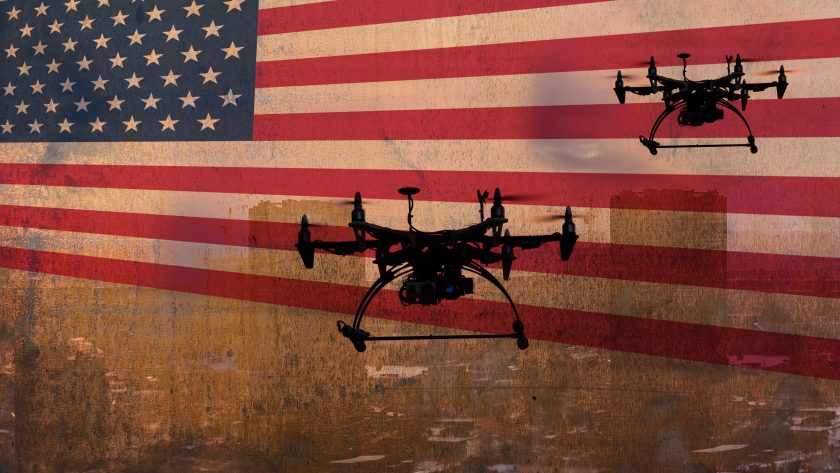The United States federal government has established the Federal Task Force to Restore American Airspace Sovereignty (Task Force) to respond to threats from uncrewed aerial systems (UAS). The Executive Order was signed by US President Donald Trump on June 6.
The Task Force will review relevant operational, technical and regulatory frameworks and develop and propose solutions to UAS threats, as appropriate and consistent with applicable law, and make recommendations on the implementation of all actions identified in the Order. The Task Force will be chaired by the Assistant to the President for National Security Affairs (APNSA) or a designee, and include principals, or their designees, from appropriate executive departments and agencies as identified by the APNSA.
Citing threats from drug cartels, terrorists and hostile foreign actors, a White House statement said “immediate action is needed to ensure American sovereignty over its skies and that its airspace remains safe and secure”.
The Order directs the Administrator of the Federal Aviation Administration (FAA) to submit a notice of proposed rulemaking (NPRM) to the Office of Management and Budget (OMB) and the Task Force establishing the statutorily required process for restricting drone flights over fixed site facilities, and interpreting, to the extent appropriate, critical infrastructure consistent with the definition of that term in this order; and promulgate a final rule as soon as practicable after publication of the NPRM. In addition, the FAA Administrator is required to make national security and homeland security assessments in coordination with relevant agencies and government departments.
Within 180 days of the date of the Order, the FAA is required to make freely available online Notices to Airmen (NOTAMs) and Temporary Flight Restrictions (TFRs) in an open format easily accepted for drone geofencing and aircraft navigation and guidance system purposes. The Order notes that this online availability should supplement, but not replace, existing NOTAMs and TFR promulgation methods.
The Order requires the Attorney General, in coordination with the Administrator of the FAA, to take appropriate steps to ensure full enforcement of applicable civil and criminal laws when drone operators endanger the public, violate established airspace restrictions, or operate a drone in furtherance of an element of another crime. On a recurring basis, the Attorney General will submit to the President, through the APNSA, legislative proposals that would revise criminal penalties for violations of restricted airspace.
Within 30 days of the date of the Order, and to the extent allowed by law, the Attorney General and the Secretary of Homeland Security are required to ensure that their respective departments’ grant programmes permit otherwise eligible State, local, tribal, and territorial (SLTT) agencies to receive grants to purchase UAS or equipment or services for the detection, tracking, or identification of drones and drone signals, consistent with the legal authorities of those SLTTs.
The Order states that executive departments and agencies will use all available existing authorities to employ equipment to detect, track, and identify drones and drone signals. The August 2020 “Advisory on the Application of Federal Laws to the Acquisition and Use of Technology to Detect and Mitigate Unmanned Aircraft Systems” will be revised to reflect relevant developments in Federal law and regulations addressing drones.
The Order instructs the Administrator of the FAA to provide, to the extent permitted by law, automated real-time access to personal identifying information associated with UAS remote identification signals to appropriate executive departments and agencies and SLTT agencies for the purposes of enforcing applicable Federal or State law, with appropriate national security and privacy safeguards.
Within 60 days, the Secretary of Homeland Security and the Administrator of the FAA will publish guidance to aid private critical infrastructure owners or operators in employing technologies to detect, track, and identify drones and drone signals.
Within 90 days, the Secretary of Homeland Security and the Attorney General, in coordination with the Secretary of Defense and the Secretary of Transportation, will submit a recommendation to the President, through the APNSA, using risk-based assessment, on whether the northern and southern land borders, large airports, federal facilities, critical infrastructure and military installations, facilities, and assets should be designated as covered facilities or assets and whether any changes to law would be necessary relating to such designation.
The Order also directs the Attorney General and the Secretary of Homeland Security to explore integrating counter-UAS operational responses as part of Joint Terrorism Task Forces for the purpose of protecting mass gathering events.
Finally, the Attorney General, in coordination with the Secretary of Defense, the Secretary of Transportation – acting through the Administrator of the FAA, the Secretary of Homeland Security, the Director of OMB and the Chairman of the Federal Communications Commission, will take appropriate steps to implement the recommendations of the March 2022 Feasibility Report to Congress with regard to the creation of the National Training Center for Counter-Unmanned Aircraft Systems (Center), and, upon establishment of the centre, focus initial training on the development of Federal and SLTT capabilities to secure major upcoming national and international sporting events held in the United States, such as the FIFA World Cup 2026 and the 2028 Summer Olympics.
For more information
The White House – Restoring American Airspace Sovereignty
Image: Shutterstock




